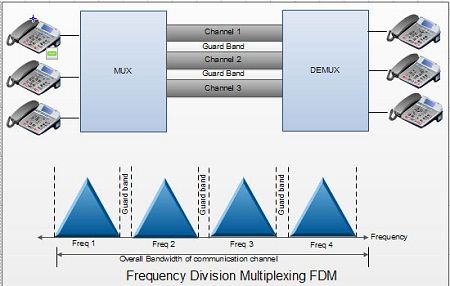Frequency-Division Multiplexing (FDM) is a scheme in which numerous signals are combined for transmission on a single communications line or channel. It is analog multiplexing technique. Each signal is assigned a different frequency (sub channel) within the main channel. its requires channel synchronization. FDM multiplexing technique is based on orthogonality of sinusoids.
FDM requires that the bandwidth of a link should be greater than the combined bandwidths of the various signals to be transmitted. Thus each signal having different frequency forms a particular logical channel on the link and follows this channel only. These channels are then separated by the strips of unused bandwidth called guard bands. These guard bands prevent the signals from overlapping as shown in Fig.
In FDM, signals to be transmitted must be analog signals. Thus digital signals need to be converted to analog form, if they are to use FDM.

A typical analog Internet connection via a twisted pair telephone line requires approximately three kilohertz (3 kHz) of bandwidth for accurate and reliable data transfer.
Twisted-pair lines are common in households and small businesses. But major telephone cables, operating between large businesses, government agencies, and municipalities, are capable of much larger bandwidths.
We’ll be covering the following topics in this tutorial:
Advantages of FDM:
1. A large number of signals (channels) can be transmitted simultaneously.
2. FDM does not need synchronization between its transmitter and receiver for proper operation.
3. Demodulation of FDM is easy.
4. Due to slow narrow band fading only a single channel gets affected.
Disadvantages of FDM:
1. The communication channel must have a very large bandwidth.
2. Intermodulation distortion takes place.
3. Large number of modulators and filters are required.
4. FDM suffers from the problem of crosstalk.
5. All the FDM channels get affected due to wideband fading.
Applications of FDM
1. FDM is used for FM & AM radio broadcasting. Each AM and FM radio station uses a different carrier frequency. In AM broadcasting, these frequencies use a special band from 530 to 1700 KHz. All these signals/frequencies are multiplexed and are transmitted in air. A receiver receives all these signals but tunes only one which is required. Similarly FM broadcasting uses a bandwidth of 88 to 108 MHz
2. FDM is used in television broadcasting.
3. First generation cellular telephone also uses FDM.
 Dinesh Thakur holds an B.C.A, MCDBA, MCSD certifications. Dinesh authors the hugely popular
Dinesh Thakur holds an B.C.A, MCDBA, MCSD certifications. Dinesh authors the hugely popular